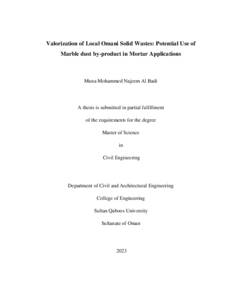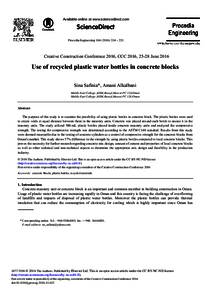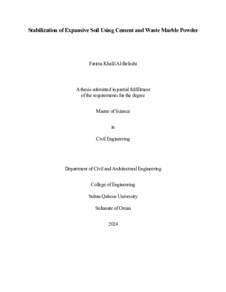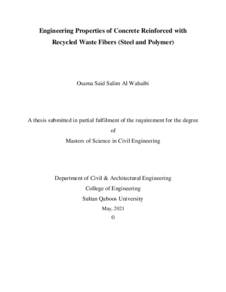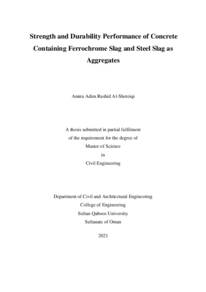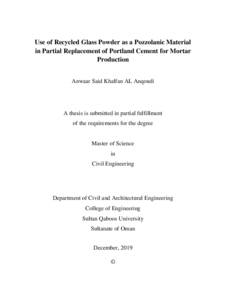Document
Valorization of local Omani solid Wastes : potential use of marble dust by-product in mortar applications.
Other titles
تثمین المخلفات الصلبة المحلیة العمانية : الاستخدام المحتمل لمخلفات غبار الرخام في تطبیقات تثمین المخلفات الصلبة المحلیة ا
Publisher
Sultan Qaboos University.
Gregorian
2023
Language
English
English abstract
Sustainability is a crucial idea that must be deep-seated and applied both locally and
globally in modern society's activities, particularly in the building sector. The most
common building materials used in construction are cement-based products, with Portland
cement as the binding material. The production of ordinary Portland cement (OPC), the
main cement type used in a wide variety of building constructions, requires the use of a
significant amount of virgin, nonrenewable natural resources and heat treatment at around
1500 °C. Both processes are very damaging to the environment, leading to extensive
depletion of natural mineral resources and accounting for about 8% of the world's CO2
emissions. To reduce cement manufacturing`s environmental impacts, partial replacement
of OPC by locally available and recycled by-product resources is one of the most practical
and efficient strategies to lower the amount of clinker cement produced and, hence, its
consequences. A fundamental requirement for developing a greener and more sustainable
construction industry is to promote the use of local and recycled materials while reducing
reliance on virgin natural resources. In this study, local waste of Marble Dust (MD) (0, 5,
10, 15, 20, 25, and 30%) by weight is used to partially replace Portland cement in binary
mortar mixes. Moreover, mortar mixtures containing an optimized percentage of 10% MD
were combined with other conventional and alternative supplementary cementitious
materials (SCMs) to develop and investigate cementitious composites performances. The
physical, chemical, microstructural, and crystallographic characteristics of materials
(mainly marble dust) were first evaluated. The fresh, mechanical, durability, and thermal
properties of blended mortar mixtures with a constant water-to-cement proportion (w/c)
of 0.30 were examined. Except for shrinkage, all hardened properties were measured after
an initial wet curing of 28 days, or as stated. The compressive strength was assessed at
various ages of 1, 7, 28, and 91 days, while the flexural strength was measured after 28
days. Other hardening and durability tests, including ultrasonic pulse velocity (UPV),
thermal conductivity, porosity and absorption, chloride permeability, and resistance to
sulfate and acids, were all conducted after 28 days. The results demonstrate that adding
different MD percentages and particle sizes did not significantly alter the fresh density,
temperature, or flowability compared to the control mix. Compressive strength slightly
improved at 10% MD; beyond this replacement level, the strength decreased. Flexural
strength and UPV values increased in most of the binary and composite cement mixes,
while there was no significant impact of the use of MD on the mortar`s thermal
conductivity. Porosity and water absorption increased when adding MD to cement mortar,
while resistance to high temperatures and acids generally decreased. However, mortar
blended with MD developed better resistance to a combined (Sulfate + chloride) attack
and chloride permeability. The findings reveal that the use of MD, a non-reactive filler
material, needs to be combined with reactive mineral admixtures such as silica fume (SF)
or fly ash (FA) to get the most benefit from it. Quaternary and quinary composite cements
and MD ternary blended cements with SF and FA have tremendously reduced the chloride
permeability from "very low" to "negligible".
Member of
Resource URL
Arabic abstract
الاستدامة ھي فكرة حاسمة یجب أن تكون متجذرة بعمق وتطبیقھا محلیا ً وعالميا في أنشطة المجتمع الحديث لاسيما في قطاع البناء. أكثر مواد البناء شیوعا المستخدمة في البناء ھي المنتجات القائمة على الأسمنت مع الأسمنت البورتلاندي كمادة ملزمة. یتطلب إنتاج الأسمنت البورتلاندي العادي (OPC(، وھو نوع الأسمنت الرئیسي المستخدم في مجموعة متنوعة من إنشاءات المباني، استخدام كمیة كبیرة من الموارد الطبیعیة البكر غیر المتجددة والمعالجة الحراریة عند حوالي 1500 درجة مئویة. كلتا العملیتین تدمران بشدة الاستنفاد البیئي الرائد للموارد المعدنیة الطبیعیة وتتسبب في حوالي 8 ٪ من انبعاثات ثاني أكسید الكربون في العالم. لتقلیل الآثار البیئیة لتصنیع الأسمنت، فإن الاستبدال ًا والمعاد تدویرھا ھي واحدة من أكثر الاستراتیجیات الجزئي لـ OPC من خلال موارد المنتجات الثانویة المتاحة محلی عملیة وكفاءة لخفض كمیة الأسمنت الكلنكر المنتج وبالتالي عواقبھ. یتمثل أحد المتطلبات الأساسیة لتطویر صناعة إنشاءات خضراء وأكثر استدامة في تعزیز استخدام المواد المحلیة والمعاد تدویرھا مع تقلیل الاعتماد على الموارد الطبیعیة البكر. في ھذه الدراسة، تم استخدام المخلفات المحلیة لغبار الرخام (MD) (،0 ،5 ،10 ،15 ،20 ،25 ٪30 ( ًا في خلیط الملاط الثنائي. علاوة على ذلك، تم دمج مخالیط الملاط التي بالوزن لاستبدال الأسمنت البورتلاندي جزئی ُ تحتوي على نسبة م َّحسنة من ٪10 MD مع مواد أسمنتیة إضافیة تقلیدیة وبدیلة أخرى (SCMs (لتطویر وفحص ً تقییم الخصائص الفیزیائیة والكیمیائیة والبنیة الدقیقة والبلوریة للمواد (غبار الرخام أداء المركبات الأسمنتیة. تم أولا بشكل أساسي). تم فحص الخواص الجدیدة والمیكانیكیة والمتانة والحراریة لخلائط الملاط المخلوطة مع نسبة ماء إلى أسمنت ثابتة (وزن / ج) تبلغ .0.30 باستثناء الانكماش، تم قیاس جمیع الخصائص الصلدة بعد معالجة رطبة أولیة لمدة 28 ً یوما أو كما ھو مذكور. تم تقییم مقاومة الانضغاط في أعمار مختلفة من 1 و7 و28 و91 ً یوما، بینما تم قیاس مقاومة الانضغاط بعد 28 ً یوما. تم إجراء اختبارات الصلابة والمتانة الأخرى بما في ذلك سرعة النبض بالموجات فوق الصوتیة (UPV (والتوصیل الحراري والمسامیة والامتصاص ونفاذیة الكلورید ومقاومة الكبریتات والأحماض بعد 28 ً یوما. توضح النتائج أن إضافة نسب MD مختلفة وأحجام الجسیمات لم تغیر بشكل كبیر من كثافة جدیدة أو درجة حرارة أو قابلیة التدفق مقارنة بمزیج التحكم. تحسنت قوة الانضغاط بشكل طفیف عند ٪10 MD، بعد مستوى الاستبدال ھذا انخفضت القوة. زادت قوة الانحناء وقیم UPV في معظم خلطات الأسمنت الثنائي والمركب بینما لا یوجد تأثیر كبیر لاستخدام MD على التوصیل الحراري للملاط. زادت المسامیة وامتصاص الماء عند إضافة MD إلى الملاط الأسمنتي. الملاط بینما تقل مقاومة درجات الحرارة العالیة والأحماض بشكل عام. ومع ذلك، طور خلیط الملاط مع MD مقاومة أفضل لھجوم (كبریتات + كلورید) ونفاذیة الكلورید. تكشف النتائج أن استخدام MD، وھو مادة حشو غیر تفاعلیة، یجب أن یتم دمجھ مع خلیط معدني تفاعلي مثل دخان السیلیكا (SF (أو الرماد المتطایر (FA ( للحصول على أقصى فائدة منھ. الأسمنت المركب الرباعي والخماسي والأسمنت المخلوط الثلاثي MD مع SF وFA viii قد قلل بشكل كبیر من نفاذیة الكلورید "منخفضة جدًا" إلى "ضئیلة".
Category
Theses and Dissertations

